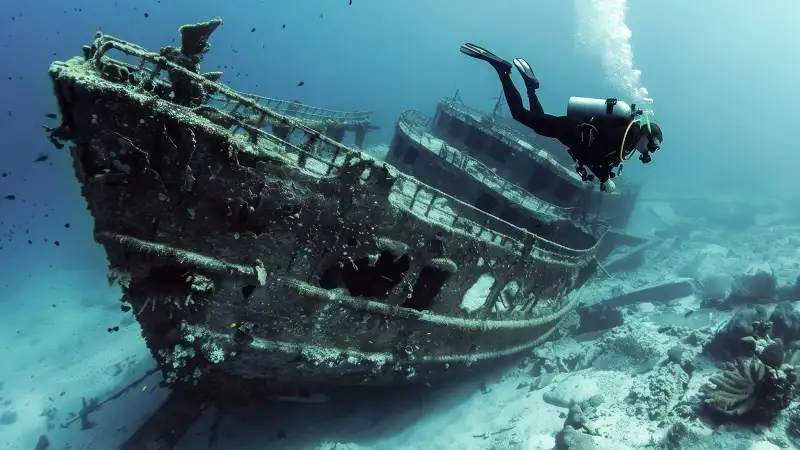The RMS underwater:4ijmtdbzi6m= titanic, a British passenger liner that sank on its maiden voyage in 1912, remains one of the most famous shipwrecks in history. Its story has fascinated generations, blending elements of tragedy, engineering marvel, and human drama. The Titanic’s resting place, deep beneath the North Atlantic Ocean, has become a focal point for underwater exploration, research, and cultural intrigue.
The Journey and the Tragic End
The Titanic’s Design and Maiden Voyage
The underwater:4ijmtdbzi6m= titanic was the largest ship afloat at the time of her maiden voyage, deemed “unsinkable” due to its advanced safety features. Constructed by Harland and Wolff in Belfast, it was a marvel of early 20th-century engineering, featuring a double bottom and watertight compartments.
On April 10, 1912, the Titanic embarked on her first voyage from Southampton to New York City, carrying 2,224 passengers and crew. The ship was a symbol of luxury and technological advancement, with opulent interiors and the latest amenities.
The Collision with the Iceberg
On the night of April 14, 1912, the Titanic struck an iceberg in the North Atlantic. Despite efforts to avoid the collision, the iceberg caused fatal damage to the ship’s hull, breaching several of her watertight compartments. Over the next few hours, the Titanic gradually filled with water and eventually broke apart, sinking into the ocean at approximately 2:20 AM on April 15.
Discovery of the Wreck
The Initial Search Efforts
Following the disaster, several attempts were made to locate the underwater:4ijmtdbzi6m= titanic wreckage, but the vast and deep North Atlantic made these efforts challenging. It wasn’t until advancements in underwater technology that the search took a significant turn.
Robert Ballard’s Expedition
In 1985, Dr. Robert Ballard and his team from the Woods Hole Oceanographic Institution successfully located the wreck of the Titanic. Using a combination of sonar and remotely operated vehicles (ROVs), they discovered the ship’s remains at a depth of about 12,500 feet (3,800 meters), approximately 370 miles (600 kilometers) south-southeast off the coast of Newfoundland.
The Underwater Exploration
The Condition of the Wreck
The underwater:4ijmtdbzi6m= titanic rests in two main sections, the bow and the stern, about 1,970 feet (600 meters) apart. Over the decades, saltwater corrosion, metal-eating bacteria, and the immense pressure of the deep ocean have significantly degraded the ship. Despite this, many parts of the ship remain remarkably well-preserved, offering a haunting glimpse into the past.
Artifacts and Discoveries
Numerous artifacts have been recovered from the Titanic’s debris field, providing invaluable insights into the lives of those on board. Items such as personal belongings, pieces of the ship’s interior, and even unopened champagne bottles have been brought to the surface. These discoveries have been crucial in understanding the day-to-day experiences of passengers and crew.
Technological Advances in Underwater Exploration
Remotely Operated Vehicles (ROVs)
ROVs have played a pivotal role in the exploration of the Titanic. These uncrewed, submersible vehicles are equipped with cameras, lights, and robotic arms, allowing scientists to navigate the wreck and collect samples without the need for human divers at extreme depths.
Submersibles
Manned submersibles have also been used to explore the Titanic. These small, deep-diving submarines can carry a crew to the ocean floor, providing firsthand observations and enabling the collection of high-quality video footage and photographs.
The Cultural Impact
Films and Documentaries
The story of the Titanic has been immortalized in numerous films and documentaries. James Cameron’s 1997 film “Titanic” is perhaps the most famous, bringing the story to life for a new generation and reigniting interest in the ship and its tragic end. Documentaries have also provided in-depth analyses of the disaster and the subsequent underwater explorations.
Museums and Exhibitions
Artifacts recovered from the Titanic have been displayed in museums around the world, attracting millions of visitors. These exhibitions offer a tangible connection to the past, allowing people to see and reflect on the items that once belonged to the passengers and crew.
Environmental Concerns
Preservation of the Site
The Titanic wreck is now considered a maritime memorial, and there is ongoing debate about the ethics of removing artifacts versus preserving the site in its current state. The United Nations Educational, Scientific and Cultural Organization (UNESCO) has advocated for the protection of the site to ensure its preservation for future generations.
Impact of Human Activity
Increased human activity around the wreck, including salvage operations and tourism, has raised concerns about the long-term impact on the site. Efforts are being made to balance exploration and preservation, ensuring that the Titanic’s legacy is respected and maintained.
Conclusion
The underwater:4ijmtdbzi6m= titanic continues to captivate and educate, offering a window into the past and a platform for technological innovation. As we advance our capabilities to explore the deep ocean, the Titanic remains a poignant reminder of human ambition, tragedy, and the enduring quest for discovery. See More
